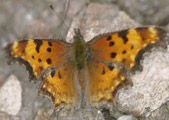Native Plants
Search for native plants by scientific name, common name or family. If you are not sure what you are looking for, try the Combination Search or our Recommended Species lists.
Rhododendron occidentale
Rhododendron occidentale (Torr. & A. Gray) A. Gray
Western Azalea
Ericaceae (Heath Family)
Synonym(s):
USDA Symbol: rhoc
USDA Native Status: L48 (N)
A fragrant, loosely branched, spreading shrub that can reach 30 ft. in height but is usually 3-9 ft. tall. The bark is shredding. The leaves are thin, light green and oval. White, tubular flowers may be tinged pink and have a yellow-blotched upper lobe. Flowers occur in tightly compact clusters. A shrub with large, white to deep pink, very fragrant flowers in large clusters at stem ends.
Flower variations include mixtures of pale pink, deep pink, and yellow-orange. An evergreen, pink-flowered relative, California Rosebay (R. macrophyllum), grows from British Columbia to California and makes a choice ornamental; it is the state flower of Washington, where it is known as Red Rhododendron.
From the Image Gallery
Plant Characteristics
Duration: PerennialHabit: Shrub
Leaf Retention: Deciduous
Leaf Arrangement: Alternate
Leaf Complexity: Simple
Breeding System: Flowers Bisexual
Fruit Type: Capsule
Size Notes: Up to about 30 feet tall, usually much shorter.
Leaf: Green
Bloom Information
Bloom Color: White , Pink , Orange , YellowBloom Time: Mar , Apr , May , Jun , Jul , Aug
Distribution
USA: CA , ORNative Distribution: CA mts. from Kern & Santa Cruz Cos., n. to s.w. OR
Native Habitat: Stream banks and other moist places below 7500 ft.
Growing Conditions
Water Use: HighLight Requirement: Part Shade
Soil Moisture: Moist
Soil pH: Acidic (pH<6.8)
CaCO3 Tolerance: None
Soil Description: Moist, well-drained soil.
Conditions Comments: A parent of many hybrid azaleas.
Benefit
Warning: Rhododendrons contain poisonous substances and should not be ingested by humans or animals. Honey made from flowers also may be toxic. POISONOUS PARTS: All parts. Highly Toxic, May be Fatal if eaten. Symptoms include salivation, watering of eyes and nose, abdominal pain, loss of energy, depression, nausea and vomiting, diarrhea, weakness, difficult breathing, progressive paralysis of arms and legs, coma. Toxic Principle: Andromedotoxin. (Poisonous Plants of N.C.)Conspicuous Flowers: yes
Value to Beneficial Insects
Special Value to Bumble BeesThis information was provided by the Pollinator Program at The Xerces Society for Invertebrate Conservation.
Butterflies and Moths of North America (BAMONA)
|
Hoary Comma (Polygonia gracilis)  Adult Food Source |
Propagation
Description: Combine seeds loosely with sphagnum moss and sprinkle lightly over a 2:1 perlite/peat mixture. Optimum temperatures for germination are 45-50 degrees. Transplant seedlings to acid soil with a high content of organic matter. Cultivated evergreen azaleasSeed Treatment: No pretreatment is necessary.
Commercially Avail: yes
National Wetland Indicator Status
| Region: | AGCP | AK | AW | CB | EMP | GP | HI | MW | NCNE | WMVE |
| Status: | FAC | FAC |
From the National Organizations Directory
According to the species list provided by Affiliate Organizations, this plant is on display at the following locations:Santa Barbara Botanic Garden - Santa Barbara, CA
Bibliography
Bibref 1186 - Field Guide to Moths of Eastern North America (2005) Covell, C.V., Jr.Bibref 1185 - Field Guide to Western Butterflies (Peterson Field Guides) (1999) Opler, P.A. and A.B. Wright
Search More Titles in Bibliography
Web Reference
Webref 38 - Flora of North America (2019) Missouri Botanical Garden, St. Louis, MO & Harvard University Herbaria, Cambridge, MA.Webref 23 - Southwest Environmental Information Network (2009) SEINet - Arizona Chapter
Additional resources
USDA: Find Rhododendron occidentale in USDA PlantsFNA: Find Rhododendron occidentale in the Flora of North America (if available)
Google: Search Google for Rhododendron occidentale
Metadata
Record Modified: 2023-04-03Research By: TWC Staff